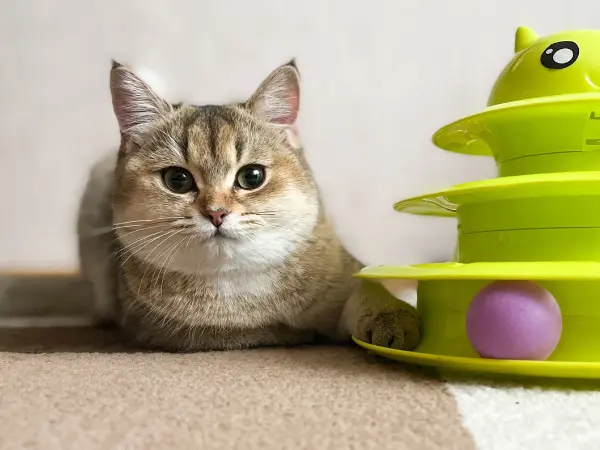Cats may appear to be free spirits, but they thrive on routine and structure. In fact, each cat may have individual daily routines consisting of ‘hunting’, eating, grooming, and sleeping.
A cat care routine works alongside your cat’s own routine; it includes a daily plan for feeding, grooming, playtime, litterbox cleaning, and so on. In this Sploot Vets guide, we'll explore the essential elements of a cat care routine to help your feline companion enjoy a healthy, active, and fabulous life.
A. Grooming & Routine Health Care for Cats
1. Cat Baths - As Needed
If cats already groom themselves, do they still need to be given baths? The answer is yes.
The ideal frequency for bathing cats depends largely on their lifestyle, environment, level of comfort, and individual situation. Generally, cats will only need baths in these circumstances:
- Cats that have gotten their fur soiled — in such cases, baths can be given as needed, especially when a cat’s self-grooming will not be effective in removing all the dirt, mud, or other particles from their fur.
- Cats that have skin problems such as bacterial infections, mange, ringworm, fleas, or ticks — for these cats, veterinarians may prescribe medicated cat baths, which tend to be required more frequently than regular baths. As an example, medicated baths can be prescribed as often as once a week.
Note: Bathing cats too frequently, over time, will dry out their skin, which opens the door for itchy skin in cats and various skin problems. This is why sticking to an intentional bathing schedule is recommended.
2. Fur Brushing Once a Day or Weekly (Depending on Fur Type)
Most cats like being brushed — if this is the case for your fur baby, it’s a great way to bond with them. Brushing also comes with practical benefits. Regular brushing helps remove loose hair and dander (especially during the cat’s shedding season); it also minimizes hairballs.
So how much brushing does a cat need? Long-haired breeds of cats (e.g., Persian, Ragdoll, Maine Coon, Himalayan) benefit from daily brushing. As for short-haired breeds (e.g, .Burmese, Scottish Fold, American Shorthair), brushing can be done at least once a week.

3. Toothbrushing Daily & Dental Cleaning Once a Year
Daily toothbrushing helps reduce the formation of disease-causing plaque and tartar. Toothbrushing for cats should be done every day or every other day, using toothpaste formulated for cats (human toothpaste is NOT safe for cats).
Note: Looking to double-check an oral health product? Our veterinarians recommend referring to the Veterinary Oral Health Council’s list of accepted products for cats. For a more personalized recommendation, ask our veterinarians during your pet’s next wellness exam!
It is important to remember that many cats exhibit reluctance towards toothbrushing. Starting training early, ideally during kittenhood, can help manage this. If training doesn't yield results, veterinarians may recommend alternatives such as dental chews, water additives, and a customized veterinary dental cleaning schedule.
In any case, annual dental exams and teeth cleaning for cats are vital. Dental cleaning, done by a veterinarian, cleans and polishes teeth in a way that toothbrushing alone cannot do. Meanwhile, dental exams assist in the early detection of cat dental problems, reducing the chances of severe tooth decay, tooth loss, and heart problems linked to periodontal disease.
4. Regular Vet Checkups Once or Twice a Year
Regular veterinary check-ups or wellness exams done once or twice a year help in the detection and early treatment of health problems.
Annual veterinary check-ups are also a great opportunity to make sure that all the bases are covered when it comes to great preventive care for cats. Preventive care for cats generally include the following:
- Updated essential cat vaccinations for rabies, FVRCP, and FeLV — some diseases covered by these essential cat vaccines are life-threatening or are carried for life.
- Heartworm prevention — please note that heartworm infections in cats there are currently no anti-heartworm medications for cats; this makes monthly heartworm prevention all the more important.
- Dental cleaning — as mentioned in the previous section, dental cleaning is a preventive measure against disease-causing plaque and tartar build-ups which can lead to tooth decay, tooth loss, and gum infections that can impact a cat’s lifespan.
B. Creating a Structured Feeding Schedule
5. Meals: Twice a Day
A structured feeding schedule helps give cats a sense of stability while also minimizing challenging behaviors like picky eating in cats. It is recommended to feed an adult cat twice daily, with about 12 hours in between feeding times.
Note: Another style of feeding is called “free feeding”, which involves leaving an entire day’s worth of meals for the cat to consume whenever they please. Typically, only dry food is used for this method. Free feeding is generally NOT recommended as it can lead to weight problems in cats.
We recommend making sure that your cat gets a well-rounded diet with a portion size that is suitable for them. A well-rounded diet includes the use of dry and wet AAFCO cat food. This mix provides cats with moisture from wet food and dental benefits from dry food.
Additionally, portion control is essential to avoid weight problems in cats. To determine the best meal portions and cat food selections for your fur baby's needs, we highly recommend scheduling a dietary consultation with a licensed veterinarian.
Looking for the best cat food for your furry companion? Here are some helpful guides you can check out:
- 7 Best Cat Foods for Indoor Cats [Wet & Dry]
- 3 Weight Loss Cat Food [& Weight Care Tips]
- 4 Best Senior Cat Foods: Why It Matters & How to Choose
- 6 Best Kitten Food for All Breeds: Wet & Dry Food [Vet-Approved]
.avif)
6. Water: Available at All Times & A Clean Bowl Daily
Proper hydration helps prevent dehydration in cats and is essential for overall health. Ensure your cat has access to clean, fresh water at all times. In addition, a cat’s water bowl needs to be cleaned every day or every other day to keep the water fresh and free of bacterial accumulation.
C. Litterbox Care & Other Hygiene Practices
7. Litterbox: Scoop Daily, Clean Out Every 2 - 4 Weeks
Spot cleaning helps keep the litter box fresh, reducing the chances of bacterial overgrowth which can lead to feline urinary tract infections (UTIs). Make sure to scoop out your cat’s litterbox every day.
Changing the litter and deep cleaning the litter box can be done every 2 weeks or every month. This depends on the type of litter your cat uses (e.g. clumping litter, grass litter, etc) and the number of cats using the litter box.
Note: When cleaning a litter box, make sure to use a mild, unscented detergent and wipe the litter box dry before putting in fresh litter.

8. Cat Bed, Tree, & Toys: Clean At Least Every 2 - 4 Weeks
Without regular cleaning, a cat’s bed, toys, and tree can become a breeding ground for bacteria and other pathogens that can cause infections.
We recommend cleaning cat toys at least every 2 weeks, or as needed. As for cat trees and cat beds, vacuuming every week and deep cleaning at least every 4 weeks would help in maintaining great hygiene for your feline friend!
D. Exercise & Playtime: Cat Toys, Cat Games & More
9. Playtime: Around 1 - 2 Times a Day
Regular playtime helps cats stay physically active and mentally stimulated. In general, cats benefit from 1 - 2 play sessions each day, spanning a few minutes each. You can make use of traditional cat toys, puzzle feeders, and even cat games to entertain your feline fur baby. Learn more in our guide: 5 Fun Games for Cats to Keep Them Fit & Sharp

10. Exercise: As Needed
An enriching cat environment can provide plenty of exercise for your cat whenever they need it. Enriching environments for cats has structures for climbing, jumping, and hiding. Learn more in our guide: How to Create an Enriching Environment to Keep Your Cat Happy
E. Sleep: 12 - 16 Hours a Day
Allowing cats to get enough sleep is yet another important aspect of establishing a cat care routine. Adult cats sleep around 12 to 16 hours a day; this is an evolutionary trait that cats have developed to conserve their energy. As a cat gets older, they may sleep for more hours than in their early adulthood.
Note: sudden lethargy and sleeping more than usual could point to a health issue in your cat. Make sure to consult a veterinarian.
F. Having the Best Pet Supplies for Your Cat
Having the right pet supplies for your cat helps ensure their well-being and comfort. Make sure to stock up on healthy cat food and treats, a cozy bed, stimulating toys, and a clean litter box. Adapting supplies to your cat's needs and preferences will promote a healthy, happy, and active lifestyle for your feline companion.
Note: Discover a range of vet-preferred pet supplies for your cat at SplootRX, an online pet store and pharmacy. SplootRX also offers convenient same- or next-day delivery, making restocking pet supplies effortless!
Final Thoughts on Establishing a Cat Care Routine
One important factor in establishing a healthy cat care routine is to schedule regular veterinary check-ups (at least once a year). This helps in the prevention and early detection/treatment of various diseases and health conditions. If your cat is in need of a wellness exam, vaccination update, and other veterinary services, Sploot is always here to help.
Get All-in-One Vet Care for Cats at Sploot Vets
Sploot Veterinary Care is a trusted veterinary clinic for cats offering all-in-one veterinary care, with primary care, urgent care, and emergency vet services all under one roof! We have multiple convenient locations in Denver, Chicago, and Colorado Springs, available 365 days a year!
With a Fear Free certified medical team, many cats feel right at home in our serene clinic spaces.
Schedule an appointment with Sploot online or through the Sploot Vets app. We’d be more than happy to help your feline companion achieve great health and well-being.
Boost Your Pet’s Wellness & Save With SplootPack™
Vet Care is now easier than ever. With the SplootPack™ membership, you can save up to $600+ on essential veterinary care—available in Sploot’s Denver and Chicago vet clinics.
Get 3 waived wellness exams or check-ups, 10% OFF on all Sploot’s services, exclusive discounts, and more!
- Learn more - SplootPack™ Denver →
- Learn more - SplootPack™ Chicago →






